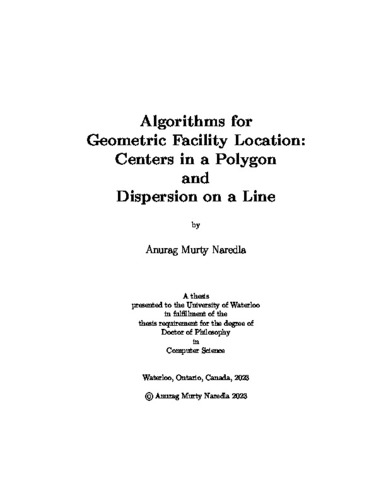| dc.description.abstract | We study three geometric facility location problems in this thesis.
First, we consider the dispersion problem in one dimension. We are given an ordered list
of (possibly overlapping) intervals on a line. We wish to choose exactly one point from
each interval such that their left to right ordering on the line matches the input order.
The aim is to choose the points so that the distance between the closest pair of points is
maximized, i.e., they must be socially distanced while respecting the order. We give a new
linear-time algorithm for this problem that produces a lexicographically optimal solution.
We also consider some generalizations of this problem.
For the next two problems, the domain of interest is a simple polygon with n vertices.
The second problem concerns the visibility center. The convention is to think of a polygon
as the top view of a building (or art gallery) where the polygon boundary represents opaque
walls. Two points in the domain are visible to each other if the line segment joining them
does not intersect the polygon exterior. The distance to visibility from a source point to a
target point is the minimum geodesic distance from the source to a point in the polygon
visible to the target. The question is: Where should a single guard be located within the
polygon to minimize the maximum distance to visibility? For m point sites in the polygon,
we give an O((m + n) log (m + n)) time algorithm to determine their visibility center.
Finally, we address the problem of locating the geodesic edge center of a simple polygon—a
point in the polygon that minimizes the maximum geodesic distance to any edge. For a
triangle, this point coincides with its incenter. The geodesic edge center is a generalization
of the well-studied geodesic center (a point that minimizes the maximum distance to any
vertex). Center problems are closely related to farthest Voronoi diagrams, which are well-
studied for point sites in the plane, and less well-studied for line segment sites in the plane.
When the domain is a polygon rather than the whole plane, only the case of point sites has
been addressed—surprisingly, more general sites (with line segments being the simplest
example) have been largely ignored. En route to our solution, we revisit, correct, and
generalize (sometimes in a non-trivial manner) existing algorithms and structures tailored
to work specifically for point sites. We give an optimal linear-time algorithm for finding
the geodesic edge center of a simple polygon. | en |

